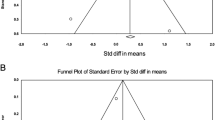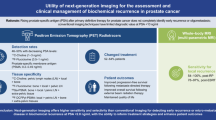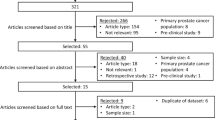Abstract
BACKGROUND: Positron emission tomography (PET or combined PET-computed tomography (PET/CT)) allows the non-invasive interrogation of metabolic processes using radiolabeled probes. Altered choline metabolism has been noted as a characteristic of prostate cancer (PCa), and radiolabeled choline and choline analogs have been investigated as PET/CT imaging agents for prostate cancer; [18F]fluoromethyl-dimethyl-2-hydroxyethyl-ammonium (18F-FCH) shows particular promise as a PCa imaging agent given its favorable physical and pharmacokinetic properties.
METHODS: We conducted a systematic review of results to date with 18F-FCH. As the tracer was first described by DeGrado in 2001, we limited our search from January 2001 to August 2011.
RESULTS: In all, 37 studies including 1244 patients met the inclusion criteria. Studies included those detailing the radiosynthesis of 18F-FCH, preclinical and early clinical dosimetry, and biodistribution (n=7); evaluation of local disease (n=6), nodal disease (n=5), bone metastases and castrate-resistant disease (n=7), biochemical recurrence (n=11), radiotherapy planning (n=7) and sources of false-positive studies (n=2); and some studies reported on multiple indications. Potential sources of variations in the studies affecting reported performance included case series size, variation in extent of disease at imaging (including Gleason grade, and PSA), selection of gold standards for comparison and variations in scan technique.
CONCLUSIONS: On the basis of the review, we suggest potential scenarios where this metabolic imaging might be considered for further evaluation in clinical trials for guiding PCa management.
This is a preview of subscription content, access via your institution
Access options
Subscribe to this journal
Receive 4 print issues and online access
$259.00 per year
only $64.75 per issue
Buy this article
- Purchase on Springer Link
- Instant access to full article PDF
Prices may be subject to local taxes which are calculated during checkout



Similar content being viewed by others
References
Chappell H, De P, Dryer D, Ellison L, Logan H, MacIntyre M et al. Canadian Cancer Statistics, 2011. Canadian Cancer Society, Statistics Canada, Provincial/Territorial Cancer Registries, Public Health Agency of Canada 2011. www.cancer.ca.
Jang TL, Han M, Roehl KA, Hawkins SA, Catalona WJ . More favorable tumor features and progression-free survival rates in a longitudinal prostate cancer screening study: PSA era and threshold-specific effects. Urology 2006; 67: 343–348.
Stamey TA, Caldwell M, McNeal JE, Nolley R, Hemenez M, Downs J . The prostate specific antigen era in the United States is over for prostate cancer: what happened in the last 20 years? J Urol 2004; 172: 1297–1301.
Hricak H, Choyke PL, Eberhardt SC, Leibel SA, Scardino PT . Imaging prostate cancer: a multidisciplinary perspective. Radiology 2007; 243: 28–53.
Oehr P, Bouchelouche K . Imaging of prostate cancer. Curr Opin Oncol 2007; 19: 259–264.
Beer AJ, Eiber M, Souvatzoglou M, Schwaiger M, Krause BJ . Radionuclide and hybrid imaging of recurrent prostate cancer. Lancet Oncol 2011; 12: 181–191.
Mattei A, Danuser H . Contemporary imaging analyses of pelvic lymph nodes in the prostate cancer patient. Curr Opin Urol 2011; 21: 211–218.
Podoloff DA, Ball DW, Ben-Josef E, Benson III AB, Cohen SJ, Coleman RE ; et al. NCCN task force: clinical utility of PET in a variety of tumor types. J Natl Compr Canc Netw 2009; 7 (Suppl 2): S1–26 (review).
Effert PJ, Bares R, Handt S, Wolff JM, Bull U, Jakse G . Metabolic imaging of untreated prostate cancer by positron emission tomography with 18fluorine-labeled deoxyglucose. J Urol 1996; 155: 994–948.
Liu IJ, Zafar MB, Lai YH, Segall GM, Terris MK . Fluorodeoxyglucose positron emission tomography studies in diagnosis and staging of clinically organ-confined prostate cancer. Urology 2001; 57: 108–111.
Shreve PD, Grossman HB, Gross MD, Wahl RL . Metastatic prostate cancer: initial findings of PET with 2-deoxy-2-[F-18]fluoro-D-glucose. Radiology 1996; 199: 751–756.
Apolo AB, Pandit-Taskar N, Morris MJ . Novel tracers and their development for the imaging of metastatic prostate cancer. J Nucl Med 2008; 49: 2031–2041.
Schuster DM, Votaw JR, Nieh PT, Yu W, Nye JA, Master V et al. Initial experience with the radiotracer anti-1-amino-3-18F-fluorocyclobutane-1-carboxylic acid with PET/CT in prostate carcinoma. J Nucl Med 2007; 48: 56–63.
Jadvar H . Prostate cancer: PET with 18F-FDG, 18F- or 11C-acetate, and 18F- or 11C-choline. J Nucl Med 2011; 52: 81–89.
Leung K . [11C]Choline. Molecular Imaging and Contrast Agent Database (MICAD) [Internet]. National Center for Biotechnology Information (US): Bethesda, MD, 2004–2011.
Leung K . [18F]Fluorocholine. Molecular Imaging and Contrast Agent Database (MICAD) [Internet]. National Center for Biotechnology Information (US): Bethesda, MD, 2004–2011.
de Certaines JD, Larsen VA, Podo F, Carpinelli G, Briot O, Henriksen O . In vivo 31P MS of experimental tumours. NMR Biomed 1993; 6: 345–365.
Negendank W . Studies of human tumors by MRS: a review. NMR Biomed 1992; 5: 303–324.
Rumsby M, Schmitt J, Sharrard M, Rodrigues G, Stower M, Maitland N . Human prostate cell lines from normal and tumourigenic epithelia differ in the pattern and control of choline lipid headgroups released into the medium on stimulation of protein kinase C. Br J Cancer 2011; 104: 673–684.
DeGrado TR, Coleman RE, Wang S, Baldwin SW, Orr MD, Robertson CN et al. Synthesis and evaluation of 18F-labeled choline as an oncologic tracer for positron emission tomography: initial findings in prostate cancer. Cancer Res 2001; 61: 110–117.
DeGrado TR, Baldwin SW, Wang S, Orr MD, Liao RP, Friedman HS et al. Synthesis and evaluation of (18)F-labeled choline analogs as oncologic PET tracers. J Nucl Med 2001; 42: 1805–1814.
DeGrado TR, Reiman RE, Price DT, Wang S, Coleman RE . Pharmacokinetics and radiation dosimetry of 18F-fluorocholine. J Nucl Med 2002; 43: 92–96.
Uusijarvi H, Nilsson LE, Bjartell A, Mattsson S . Biokinetics of 18F-choline studied in four prostate cancer patients. Radiat Prot Dosimetry 2010; 139: 240–244.
Price DT, Coleman RE, Liao RP, Robertson CN, Polascik TJ, DeGrado TR . Comparison of [18F]fluorocholine and [18F]fluorodeoxyglucose for positron emission tomography of androgen dependent and androgen independent prostate cancer. J Urol 2002; 168: 273–280.
Kryza D, Tadino V, Filannino MA, Villeret G, Lemoucheux L . Fully automated [18F]fluorocholine synthesis in the TracerLab MX FDG coincidence synthesizer. Nucl Med Biol 2008; 35: 255–260.
Shao X, Hockley BG, Hoareau R, Schnau PL, Scott PJ . Fully automated preparation of [11C]choline and [18F]fluoromethylcholine using TracerLab synthesis modules and facilitated quality control using analytical HPLC. Appl Radiat Isot 2011; 69: 403–409.
Kwee SA, Coel MN, Lim J, Ko JP . Prostate cancer localization with 18fluorine fluorocholine positron emission tomography. J Urol 2005; 173: 252–255.
Kwee SA, Wei H, Sesterhenn I, Yun D, Coel MN . Localization of primary prostate cancer with dual-phase 18F-fluorocholine PET. J Nucl Med 2006; 47: 262–269.
Kwee SA, Thibault GP, Stack RS, Coel MN, Furusato B, Sesterhenn IA . Use of step-section histopathology to evaluate (18)F-fluorocholine PET sextant localization of prostate cancer. Mol Imag 2008; 7: 12–20.
Beheshti M, Imamovic L, Broinger G, Vali R, Waldenberger P, Stoiber F et al. 18F choline PET/CT in the preoperative staging of prostate cancer in patients with intermediate or high risk of extracapsular disease: a prospective study of 130 patients. Radiology 2010; 254: 925–933.
Igerc I, Kohlfurst S, Gallowitsch HJ, Matschnig S, Kresnik E, Gomez-Segovia I et al. The value of 18F-choline PET/CT in patients with elevated PSA-level and negative prostate needle biopsy for localisation of prostate cancer. Eur J Nucl Med Mol Imag 2008; 35: 976–983.
Schmid DT, John H, Zweifel R, Cservenyak T, Westera G, Goerres GW et al. Fluorocholine PET/CT in patients with prostate cancer: initial experience. Radiology 2005; 235: 623–628.
Poulsen MH, Bouchelouche K, Gerke O, Petersen H, Svolgaard B, Marcussen N et al. [18F]-fluorocholine positron-emission/computed tomography for lymph node staging of patients with prostate cancer: preliminary results of a prospective study. BJU Int 2010; 106: 639–643; discussion 44.
Beauregard JM, Williams SG, Degrado TR, Roselt P, Hicks RJ . Pilot comparison of F-fluorocholine and F-fluorodeoxyglucose PET/CT with conventional imaging in prostate cancer. J Med Imag Radiat Oncol 2010; 54: 325–332.
Hacker A, Jeschke S, Leeb K, Prammer K, Ziegerhofer J, Sega W et al. Detection of pelvic lymph node metastases in patients with clinically localized prostate cancer: comparison of [18F]fluorocholine positron emission tomography-computerized tomography and laparoscopic radioisotope guided sentinel lymph node dissection. J Urol 2006; 176: 2014–2018; discussion 8–9.
Husarik DB, Miralbell R, Dubs M, John H, Giger OT, Gelet A et al. Evaluation of [(18)F]-choline PET/CT for staging and restaging of prostate cancer. Eur J Nucl Med Mol Imag 2008; 35: 253–263.
Beheshti M, Vali R, Waldenberger P, Fitz F, Nader M, Loidl W et al. Detection of bone metastases in patients with prostate cancer by 18F fluorocholine and 18F fluoride PET-CT: a comparative study. Eur J Nucl Med Mol Imag 2008; 35: 1766–1774.
Beheshti M, Vali R, Waldenberger P, Fitz F, Nader M, Hammer J et al. The use of F-18 choline PET in the assessment of bone metastases in prostate cancer: correlation with morphological changes on CT. Mol Imag Biol 2009; 11: 446–454.
Kwee SA, Coel MN, Ly BH, Lim J . (18)F-choline PET/CT imaging of RECIST measurable lesions in hormone refractory prostate cancer. Ann Nucl Med 2009; 23: 541–548.
Langsteger W, Balogova S, Huchet V, Beheshti M, Paycha F, Egrot C et al. Fluorocholine (18F) and sodium fluoride (18F) PET/CT in the detection of prostate cancer: prospective comparison of diagnostic performance determined by masked reading. Q J Nucl Med Mol Imaging 2011; 55: 448–457.
Cimitan M, Bortolus R, Morassut S, Canzonieri V, Garbeglio A, Baresic T et al. [18F]fluorocholine PET/CT imaging for the detection of recurrent prostate cancer at PSA relapse: experience in 100 consecutive patients. Eur J Nucl Med Mol Imag 2006; 33: 1387–1398.
Heinisch M, Dirisamer A, Loidl W, Stoiber F, Gruy B, Haim S et al. Positron emission tomography/computed tomography with F-18-fluorocholine for restaging of prostate cancer patients: meaningful at PSA <5 ng/ml? Mol Imag Biol 2006; 8: 43–48.
Pelosi E, Arena V, Skanjeti A, Pirro V, Douroukas A, Pupi A et al. Role of whole-body 18F-choline PET/CT in disease detection in patients with biochemical relapse after radical treatment for prostate cancer. Radiol Med 2008; 113: 895–904.
Steiner C, Vees H, Zaidi H, Wissmeyer M, Berrebi O, Kossovsky MP et al. Three-phase 18F-fluorocholine PET/CT in the evaluation of prostate cancer recurrence. Nuklearmedizin 2009; 48: 1–9; quiz N2–3.
Vees H, Buchegger F, Albrecht S, Khan H, Husarik D, Zaidi H et al. 18F-choline and/or 11C-acetate positron emission tomography: detection of residual or progressive subclinical disease at very low prostate-specific antigen values (<1 ng/ml) after radical prostatectomy. BJU Int 2007; 99: 1415–1420.
Panebianco V, Sciarra A, Lisi D, Galati F, Buonocore V, Catalano C et al. Prostate cancer: 1HMRS-DCEMR at 3T versus [(18)F]choline PET/CT in the detection of local prostate cancer recurrence in men with biochemical progression after radical retropubic prostatectomy (RRP). Eur J Radiol 2011 (in press).
Casamassima F, Masi L, Menichelli C, Bonucci I, Casamassima E, Lazzeri M et al. Efficacy of eradicative radiotherapy for limited nodal metastases detected with choline PET scan in prostate cancer patients. Tumori 2011; 97: 49–55.
McCarthy M, Siew T, Campbell A, Lenzo N, Spry N, Vivian J et al. (1)F-Fluoromethylcholine (FCH) PET imaging in patients with castration-resistant prostate cancer: prospective comparison with standard imaging. Eur J Nucl Med Mol Imag 2011; 38: 14–22.
Pinkawa M, Attieh C, Piroth MD, Holy R, Nussen S, Klotz J et al. Dose-escalation using intensity-modulated radiotherapy for prostate cancer—evaluation of the dose distribution with and without 18F-choline PET-CT detected simultaneous integrated boost. Radiother Oncol 2009; 93: 213–219.
Pinkawa M, Holy R, Piroth MD, Klotz J, Nussen S, Krohn T et al. Intensity-modulated radiotherapy for prostate cancer implementing molecular imaging with 18F-choline PET-CT to define a simultaneous integrated boost. Strahlenther Onkol 2010; 186: 600–606.
Wang H, Vees H, Miralbell R, Wissmeyer M, Steiner C, Ratib O et al. 18F-fluorocholine PET-guided target volume delineation techniques for partial prostate re-irradiation in local recurrent prostate cancer. Radiother Oncol 2009; 93: 220–225.
Weber DC, Wang H, Cozzi L, Dipasquale G, Khan HG, Ratib O et al. RapidArc, intensity modulated photon and proton techniques for recurrent prostate cancer in previously irradiated patients: a treatment planning comparison study. Radiat Oncol 2009; 4: 34.
Niyazi M, Bartenstein P, Belka C, Ganswindt U . Choline PET based dose-painting in prostate cancer—modelling of dose effects. Radiat Oncol 2010; 5: 23.
Ciernik IF, Brown DW, Schmid D, Hany T, Egli P, Davis JB . 3D-segmentation of the 18F-choline PET signal for target volume definition in radiation therapy of the prostate. Technol Cancer Res Treat 2007; 6: 23–30.
Roef M, Vogel WV . The effects of muscle exercise and bed rest on [18F]methylcholine PET/CT. Eur J Nucl Med Mol Imag 2011; 38: 526–530.
Schillaci O, Calabria F, Tavolozza M, Ciccio C, Carlani M, Caracciolo CR et al. 18F-choline PET/CT physiological distribution and pitfalls in image interpretation: experience in 80 patients with prostate cancer. Nucl Med Commun 2010; 31: 39–45.
DeGrado TR, Kwee SA, Coel MN, Coleman RE . impact of urinary excretion of (18)F-labeled choline analogs. J Nucl Med 2007; 48: 1225.
Kwee SA, DeGrado T . Prostate biopsy guided by 18F-fluorocholine PET in men with persistently elevated PSA levels. Eur J Nucl Med Mol Imag 2008; 35: 1567–1569; author reply 70.
Viani GA, Stefano EJ, Afonso SL . Higher-than-conventional radiation doses in localized prostate cancer treatment: a meta-analysis of randomized, controlled trials. Int J Radiat Oncol Biol Phys 2009; 74: 1405–1418.
Bott SR, Ahmed HU, Hindley RG, Abdul-Rahman A, Freeman A, Emberton M . The index lesion and focal therapy: an analysis of the pathological characteristics of prostate cancer. BJU Int 2010; 106: 1607–1611.
Karavitakis M, Ahmed HU, Abel PD, Hazell S, Winkler MH . Tumor focality in prostate cancer: implications for focal therapy. Nat Rev Clin Oncol 2011; 8: 48–55.
Mouraviev V, Mayes JM, Polascik TJ . Basis of focal therapy for early-stage prostate cancer. Nat Rev Urol 2009; 6: 205–215.
Stephenson AJ, Scardino PT, Kattan MW, Pisansky TM, Slawin KW, Klein EA et al. Predicting the outcome of salvage radiation therapy for recurrent prostate cancer after radical prostatectomy. J Clin Oncol 2007; 25: 2035–2041.
Acknowledgements
This work supported by the Canadian Institute for Health Research (Grant CTP 87515) and the Centre for Probe Development and Commercialization.
Author information
Authors and Affiliations
Corresponding author
Ethics declarations
Competing interests
The authors declare no conflict of interest.
Rights and permissions
About this article
Cite this article
Bauman, G., Belhocine, T., Kovacs, M. et al. 18F-fluorocholine for prostate cancer imaging: a systematic review of the literature. Prostate Cancer Prostatic Dis 15, 45–55 (2012). https://doi.org/10.1038/pcan.2011.35
Received:
Revised:
Accepted:
Published:
Issue Date:
DOI: https://doi.org/10.1038/pcan.2011.35
Keywords
This article is cited by
-
Does whole-body bone SPECT/CT provide additional diagnostic information over [18F]-FCH PET/CT for the detection of bone metastases in the setting of prostate cancer biochemical recurrence?
Cancer Imaging (2020)
-
Impact of penalizing factor in a block-sequential regularized expectation maximization reconstruction algorithm for 18F-fluorocholine PET-CT regarding image quality and interpretation
EJNMMI Physics (2019)
-
New approaches for effective and safe pelvic radiotherapy in high-risk prostate cancer
Nature Reviews Urology (2019)
-
F18-choline/C11-choline PET/CT thyroid incidentalomas
Endocrine (2019)
-
Quantitative 18F-fluorocholine positron emission tomography for prostate cancer: correlation between kinetic parameters and Gleason scoring
EJNMMI Research (2017)



